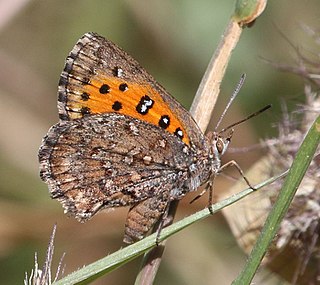
The following is a list of public holidays in Romania. According to Romanian law, Romania had 51 public holidays as of 2011, which cover 14% of the days of the year in the country.

The Hepialidae are a family of insects in the lepidopteran order. Moths of this family are often referred to as swift moths or ghost moths.

The Hepialoidea are the superfamily of "ghost moths" and "swift moths".
Antihepialus is a genus of moths of the family Hepialidae. There are four described species, found in southern and eastern Africa.

The insect order Lepidoptera consists of moths, most of which are night-flying, and a derived group, mainly day-flying, called butterflies. Within Lepidoptera as a whole, the groups listed below before Glossata contain a few basal families accounting for less than 200 species; the bulk of Lepidoptera are in the Glossata. Similarly, within the Glossata, there are a few basal groups listed first, with the bulk of species in the Heteroneura. Basal groups within Heteroneura cannot be defined with as much confidence, as there are still some disputes concerning the proper relations among these groups. At the family level, however, most groups are well defined, and the families are commonly used by hobbyists and scientists alike.
Thestor vansoni, the Van Son's skolly, is a butterfly of the family Lycaenidae. It is found in South Africa, where it is found in the Nama Karoo just below the peaks of the Gydoberg, the Skurweberg and the Cederberg in the Western Cape.
Deudorix vansoni, the Van Son's playboy, is a butterfly of the family Lycaenidae. It is found from northern KwaZulu-Natal to Swaziland, then along the Lebombo foothills to southern Mpumalanga and north to Zimbabwe and Malawi.

Aloeides vansoni, the Van Son's copper, is a butterfly of the family Lycaenidae. It is found in South Africa, where it is known from the Western Cape, then across the Great Karoo and Roggeveld escarpment, south along the north side of the Swartberg and nearby mountains to the Eastern Cape.
Lepidochrysops vansoni, the Van Son's blue, is a butterfly of the family Lycaenidae. It is found in Limpopo in South Africa, north to Botswana and Zimbabwe.
Charaxes vansoni, the Van Son's emperor, is a butterfly of the family Nymphalidae. It is found in southern Africa.

Phyllonorycter is a genus of moths in the family Gracillariidae.
Ceromitia vansoni is a species of moth of the family Adelidae. It is known from South Africa.

Epicrocis is a genus of snout moths. It was described by Philipp Christoph Zeller in 1848.
Epicrocis vansoni is a species of snout moth in the genus Epicrocis. It was described by Boris Balinsky in 1994 and is found in South Africa.
Antihepialus antarcticus is a species of moth of the family Hepialidae. It is known from South Africa.
Antihepialus capeneri is a species of moth of the family Hepialidae. It is known from South Africa.
Antihepialus keniae is a species of moth of the family Hepialidae described by William Jacob Holland in 1892. It is known from Kenya, Tanzania and Uganda.

De Prins van Oranje is a tower mill in Bredevoort, Gelderland, Netherlands which was built in 1870 and has been restored to working order. The mill is listed as a Rijksmonument.

Pachydactylus vansoni, commonly known as Van Son's gecko or Van Son's thick-toed gecko, is a species of lizard in the family Gekkonidae. The species is endemic to Southern Africa.
The Macroheterocera are a well supported clade of moths that are closely related to butterflies and other macro-moths.







